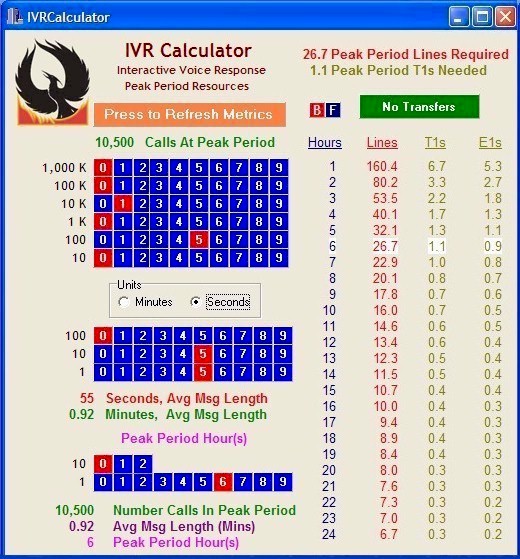|
|

IVR Resource Calculator
Interactive Voice Response
IVR Resource Modeling
 An Interactive Voice Response (IVR) processes inbound phone calls and can play recorded messages including information extracted from databases and the internet.
An Interactive Voice Response (IVR) processes inbound phone calls and can play recorded messages including information extracted from databases and the internet.
An IVR system can collect caller information and transmit this to a data center for processing. If the caller wishes to speak with a "live" person, the IVR can route calls to either in-house service agents or transfer the caller to an outside extension.
The IVR modeling program is a resource calculator that estimates the amount of phone lines and supporting telecommunication equipment required to handle this type of automatic phone answering.
The IVR model calculates incoming phone lines and system requirements for an inbound calling campaign. It estimates the number of lines required to handle peak load processing of these calls.
Note - this model assumes that calls are evenly distributed during peak periods of operation. The ideal calculation run will narrow the peak period, thus providing a realistic assessment of the telecom requirements. A too narrow peak period, however, will inflate the amount of resources required, resulting in wasted resources and the associated expense.
The following is sample run using the IVR simulation program and the its results.
IVR Model Input Parameters
The following input parameters are required to run the IVR simulation model program:
|
Average Call Length (Seconds)
|
This is the estimated time spent by a caller in the IVR system. The more complex an IVR program, the more difficult it will be to make this estimate, especially if the IVR routes callers to inside call agents or transfers the call to an outside line.
|
|
Peak Number of Calls
|
This parameter is used in conjunction with the next parameter (Peak number of hours). It is the total number of calls expected to be received by the IVR phone system during the peak hours. For example, if the peak call period is between 9AM and 3PM and 10500 calls are expected to be received during that period, this parameter would be set to 10500 and the next parameter would be set to 6 hours.
|
|
Peak Call Time Period (Hours)
|
Time period during the day (in hours) when you expect to receive the most calls. (Used with prior parameter).
|
Sample IVR Calculator Program Run
Here is a sample run of the IVR simulation program that uses the following input parameters:
|
Average Call Length
|
55
|
|
Peak Number of Calls
|
10500
|
|
Peak Call Time Period
|
6
|
Sample IVR Calculation Program Display

IVR Calculator Results
The display above indicates that to process the number of calls specified in the input parameters would require 26.7 phone lines (upper right hand part of display). Also provided is a table of line requirements based upon a shorter or longer peak time period during which the number of peak calls would be received.
These results would indicate that a dual T1 system (with 48 lines) or an analog phone system supporting 28 lines would be required to handle this call volume with minimal busy signal responses to the callers.
Contact DSC
Contact DSC for a FREE IVR simulation run and analysis and to learn more about IVR call center products and services.
|
|


 An
An 